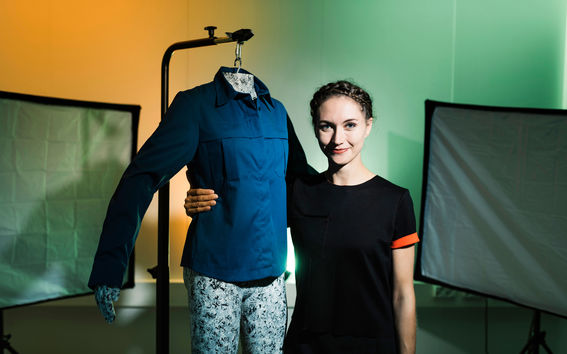
“I’ve been a gamer since I was ten. Even back then, I’d wonder who designed the costumes worn by game characters. The video game industry felt distant, however, as I prefer to make things with my hands,” says Heli Salomaa. She recently graduated from the costume design Master’s programme at Aalto University.
“I had worked on theatre and performance costumes prior to my studies, but as a person I crave the new and wanted to test the boundaries of costume design. My studies introduced me to laser cutters and 3D printers at the University’s Fablab, so I began to integrate these methods into my costume designs. At Fablab I realised that technology isn’t so hard after all. The video game industry no longer felt like a utopian dream, it was a potential workplace instead.”
After this insight, Heli Salomaa freshened up her CV. A couple of years ago, she took part in the Aalto in the Game fair, and then things started happening rapidly. She met a recruiter from Remedy Entertainment, a producer of realistic big-budget AAA video games, at the fair and spoke about her interest in getting involved in game character design.
Her timing was impeccable; Remedy’s previous game, Quantum Break, had just been released and a new game called Control, which was scheduled for release in 2019, was in its early design stages. Remedy’s lead character artist had already suggested getting help for designing the clothing of the game’s characters. Salomaa was directed to speak with him, and started working as a costume artist a few months later.
Thesis earns distinction
Making games that imitate the real world is a complex process that requires seamless teamwork.
During her first year, Salomaa got to know in detail what the members of the design team were doing and what stages she could get involved in. Salomaa combined the linear process of physical costume design and Remedy’s character design process to form a new virtual clothing production line, creating something that has not been employed elsewhere. The makers of international smash hits Grand Theft Auto 5 and L.A. Noire, for example, had hired big-name costume designers from outside the industry. Their approach to the game characters resembled the costuming of a TV show, i.e. they employed analogue methods.
“The people at Remedy are incredibly open-minded – they hired me even though my competence was based on analogue costume design. We didn’t even share a vocabulary at first. I also learned how to use the necessary software, starting from Photoshop, while working at the company,” Salomaa says.
“Game makers create huge worlds and technology is taking big leaps forward. The realistic digitisation of physicality, such as architecture or the interaction between the human body and clothing, creates new types of interfaces for association. I’ve been involved with the game Control almost from the very start.”
Salomaa wrote her thesis on the process of virtual character design and received two awards for her outstanding work. Her distinguished thesis documented the digital costume design methods and programs employed by Salomaa that any costume designer wishing to find employment in, for example, the video game industry or animation, must master.
“Anything’s possible in the virtual world. I can design things that cannot be realised on stage, such as costumes that defy the laws of physics.”
Costumes designed by Heli Salomaa will be seen in the following productions in 2019
- music and dance film Mirages. Composer: Kaija Saariaho; screenplay and direction: Marikki Hakola (mirages.fi)
- video game Control. Producer: Remedy Entertainment (controlgame.com)
Text: Tiina Toivola. Photo: Jaakko Kahilaniemi.
This article is published in the Aalto University Magazine issue 23 (issuu.com), October 2018.
- Published:
- Updated:
Read more news

This is how smart textiles can look like: self-cleaning cotton or a colour-changing print
An article by YLE Svenska about 'Beyond e-Textiles' project and 'Interlaced' exhibition at the University of Turku
A new project in Espoo aims to improve disparities in children's learning outcomes – with the goal of preventing social segregation
Supporting children's learning skills has a major impact on their further education and employment, among other things.
Can the impact of performing arts be measured? Researchers record applause and CO2 levels in Kapsäkki's UKK musical
The UKK musical, produced by Music Theatre Kapsäkki and Greta Production, is a vibrant cabaret about Finland’s political history during the era of President Kekkonen. Its impact is now being studied scientifically. The research, conducted in collaboration with Aalto University's MAGICS infrastructure, Greta Production, and Kapsäkki, measures audience and performer experiences through innovative methods, including various sensors and surveys.